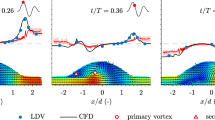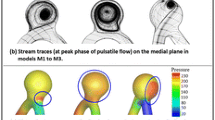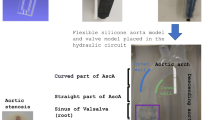Abstract
We carry out high-resolution laboratory experiments and numerical simulations to investigate the dynamics of unsteady vortex formation across the neck of an anatomic in vitro model of an intracranial aneurysm. A transparent acrylic replica of the aneurysm is manufactured and attached to a pulse duplicator system in the laboratory. Time-resolved three-dimensional three-component velocity measurements are obtained inside the aneurysm sac under physiologic pulsatile conditions. High-resolution numerical simulations are also carried out under conditions replicating as closely as possible those of the laboratory experiment. Comparison of the measured and computed flow fields shows very good agreement in terms of instantaneous velocity fields and three-dimensional coherent structures. Both experiments and numerical simulations show that a well-defined vortical structure is formed near the proximal neck at early systole. This vortical structure is advected by the flow across the aneurysm neck and impinges on the distal wall. The results underscore the complexity of aneurysm hemodynamics and point to the need for integrating high-resolution, time-resolved three-dimensional experimental and computational techniques. The current work emphasizes the importance of vortex formation phenomena at aneurysmal necks and reinforces the findings of previous computational work and recent clinical studies pointing to links between flow pulsatility and aneurysm growth and rupture.










Similar content being viewed by others
References
Baek, H., M. Jayaraman, P. Richardson, and G. Karniadakis. Flow instability and wall shear stress variation in intracranial aneurysms. J. R. Soc. Interface 7(47):967–988, 2010.
Bijari, P. B., L. Antiga, D. Gallo, B. A. Wasserman, and D. A. Steinman. Improved prediction of disturbed flow via hemodynamically-inspired geometric variables. J. Biomech. 2012
Borazjani, I., and L. Ge. Sotiropoulos, Fotis. Curvilinear immersed boundary method for simulating fluid structure interaction with complex 3D rigid bodies. J. Comput. Phys. 227:7587–7620, 2008.
Boutsianis, E., M. Guala, U. Olgac, et al. CFD and PTV steady flow investigation in an anatomically accurate abdominal aortic aneurysm. J. Biomech. Eng. 131:011008–011001.
Cantón, G., D. I. Levy, J. C. Lasheras, and P. K. Nelson. Flow changes caused by the sequential placement of stents across the neck of sidewall cerebral aneurysms. J. Neurosurg. 103(5):891–902, 2005.
Cebral, J. R., M. A. Castro, S. Appanaboyina, C. M. Putman, D. Millan, and A. F. Frangi. Efficient pipeline for image-based patient-specific analysis of cerebral aneurysm hemodynamics: technique and sensitivity. IEEE Trans. Med. Imaging 24(4):457–467, 2005.
Ford, M. D., H. N. Nikolov, J. S. Milner, et al. PIV-measured versus CFD-predicted flow dynamics in anatomically realistic cerebral aneurysm models. J. Biomech. Eng. 130:021015, 2008.
Ford, M. D., and U. Piomelli. Exploring high frequency temporal fluctuations in the terminal aneurysm of the basilar bifurcation. J. Biomech. Eng. 134(9):091003, 2012.
Gallo, D., D. A. Steinman, P. B. Bijari, and U. Morbiducci. Helical flow in carotid bifurcation as surrogate marker of exposure to disturbed shear. J. Biomech. 2012.
Ge, L., and F. Sotiropoulos. A numerical method for solving the 3D unsteady incompressible Navier-Stokes equations in curvilinear domains with complex immersed boundaries. J. Comput. Phys. 225:1782, 2007.
Gharib, M., E. Rambod, and K. Shariff. A universal time scale for vortex ring formation. J. Fluid Mech. 360(1):121, 1998.
Gilmanov, A., and F. Sotiropoulos. A hybrid Cartesian/immersed boundary method for simulating flows with 3D, geometrically complex, moving bodies. J. Comput. Phys. 207(2):457–492, 2005.
Gosling, R., and D. King. Arterial assessment by Doppler-shift ultrasound. Proc. R. Soc. Med. 67(6 Pt 1):447, 1974.
Helmlinger, G., R. Geiger, S. Schreck, and R. Nerem. Effects of pulsatile flow on cultured vascular endothelial cell morphology. J. Biomech. Eng. 113(2):123, 1991.
Hoi, Y., S. H. Woodward, M. Kim, D. B. Taulbee, and H. Meng. Validation of CFD simulations of cerebral aneurysms with implication of geometric variations. J. Biomech. Eng. 128(6):844, 2006.
Holdsworth, D. W., C. J. D. Norley, R. Frayne, D. A. Steinman, and B. K. Rutt. Characterization of common carotid artery blood-flow waveforms in normal human subjects. Physiol. Meas. 20(3):219, 1999.
Hope, T. A., M. D. Hope, D. D. Purcell, et al. Evaluation of intracranial stenoses and aneurysms with accelerated 4D flow. Magn. Reson. Imaging 28(1):41–46, 2010.
Hunt, J. C. R., A. A. Wray, and P. Moin. Eddies, stream, and convergence zones in turbulent flows. Center for Turbulence Research Report CTR-S88. 1988:193-208.
Kadirvel, R., Y.-H. Ding, D. Dai, et al. The influence of hemodynamic forces on biomarkers in the walls of elastase-induced aneurysms in rabbits. Neuroradiology 49(12):1041–1053, 2007.
Ku, D. N. Blood flow in arteries. Annu. Rev. Fluid Mech. 29(1):399–434, 1997.
Ku, D. N., D. P. Giddens, C. K. Zarins, and S. Glagov. Pulsatile flow and atherosclerosis in the human carotid bifurcation. Positive correlation between plaque location and low oscillating shear stress. Arterioscler. Thromb. Vasc. Biol. 5(3):293–302, 1985.
Le, B. T., I. Borazjani, and F. Sotiropoulos. Pulsatile flow effects on the hemodynamics of intracranial aneurysms. J. Biomech. Eng. 132(11):111009–111011.
Le, T. B., and F. Sotiropoulos. Fluid-structure interaction of an aortic heart valve prosthesis driven by an animated anatomic left ventricle. J. Comput. Phys. 2012.
Le, T. B., I. Borazjani, S. Kang, and F. Sotiropoulos. On the structure of vortex rings from inclined nozzles. J. Fluid Mech. 686(-1):451–483, 2011.
Lee, S.-W., L. Antiga, J. D. Spence, and D. A. Steinman. Geometry of the carotid bifurcation predicts its exposure to disturbed flow. Stroke 39(8):2341–2347, 2008.
Lindegaard, K.-F., S. J. Bakke, P. Grolimund, R. Aaslid, P. Huber, and H. Nornes. Assessment of intracranial hemodynamics in carotid artery disease by transcranial Doppler ultrasound. J. Neurosurg. 63(6):890–898, 1985.
Liou, T.-M., and Y.-C. Li. Effects of stent porosity on hemodynamics in a sidewall aneurysm model. J. Biomech. 41(6):1174–1183, 2008.
Marshall, I., P. Papathanasopoulou, and K. Wartolowska. Carotid flow rates and flow division at the bifurcation in healthy volunteers. Physiol. Meas. 25(3):691, 2004.
Meckel, S., A. F. Stalder, F. Santini, et al. In vivo visualization and analysis of 3-D hemodynamics in cerebral aneurysms with flow-sensitized 4-D MR imaging at 3 T. Neuroradiology 50(6):473–484, 2008.
Palero, V. R., J. Lobera, and M. P. Arroyo. Three-component velocity field measurement in confined liquid flows with high-speed digital image plane holography. Exp. Fluids 49(2):471–483, 2010.
Patti, J., F. Viñuela, and A. Chien. Distinct trends of pulsatility found at the necks of ruptured and unruptured aneurysms. J. NeuroInterv. Surg. 2013
Pereira, F., H. Stüer, E. C. Graff, and M. Gharib. Two-frame 3D particle tracking. Meas. Sci. Technol. 17(7):1680, 2006.
Perktold, K., K. Gruber, T. Kenner, and H. Florian. Calculation of pulsatile flow and particle paths in an aneurysm-model. Basic Res. Cardiol. 79(3):253–261, 1984.
Seong, J., A. K. Wakhloo, and B. B. Lieber. In vitro evaluation of flow divertors in an elastase-induced saccular aneurysm model in rabbit. J. Biomech. Eng. 129(6):863, 2007.
Sforza, D. M., C. M. Putman, and J. R. Cebral. Hemodynamics of cerebral aneurysms. Annu. Rev. Fluid Mech. 41:91, 2009.
Steinman, D. Computational modeling and flow diverters: a teaching moment. Am. J. Neuroradiol. 32(6):981–983, 2011.
Steinman, D. A., J. S. Milner, C. J. Norley, S. P. Lownie, and D. W. Holdsworth. Image-based computational simulation of flow dynamics in a giant intracranial aneurysm. Am. J. Neuroradiol. 24(4):559–566, 2003.
Troolin, D. R., and E. K. Longmire. Volumetric velocity measurements of vortex rings from inclined exits. Exp. Fluids 48(3):409–420, 2010.
Ugron, Á., M.-I. Farinas, L. Kiss, and G. Paál. Unsteady velocity measurements in a realistic intracranial aneurysm model. Exp. Fluids 52(1):37–52, 2012.
Valencia, A., S. Botto, J. Sordo, M. Galvez, and L. Badilla. Comparison of haemodynamics in cerebral aneurysms of different sizes located in the ophthalmic artery. Int. J. Numer. Methods Fluids 53(5):793–809, 2006.
Valen-Sendstad, K., K.-A. Mardal, and D. A. Steinman. High-resolution computational fluid dynamics detects high-frequency velocity fluctuations in bifurcation, but not sidewall, aneurysms of the middle cerebral artery. J. Biomech. 2012.
Van Ooij, P., A. Guédon, C. Poelma, et al. Complex flow patterns in a real-size intracranial aneurysm phantom: phase contrast MRI compared with particle image velocimetry and computational fluid dynamics. NMR Biomed. 25(1):14–26, 2012.
White, C. R., M. Haidekker, X. Bao, and J. A. Frangos. Temporal gradients in shear, but not spatial gradients, stimulate endothelial cell proliferation. Circulation 103(20):2508–2513, 2001.
Willert, C., and M. Gharib. Digital particle image velocimetry. Exp. Fluids 10(4):181–193, 1991.
Acknowledgments
Financial support for this work is from a grant from Mayo Clinic. We would like to thank Dr. David Kallmes for providing us the anatomic aneurysm geometry. We gratefully acknowledge the support of Minnesota Supercomputing Institute for the computational time. The first author (Trung Bao Le) is supported partially by a pre-doctoral fellowship from Vietnam Education Foundation.
Conflict of interest
None.
Author information
Authors and Affiliations
Corresponding author
Additional information
Associate Editor Michael R. King oversaw the review of this article.
Electronic supplementary material
Below is the link to the electronic supplementary material.
Supplementary material 2 (MOV 9884 kb)
Rights and permissions
About this article
Cite this article
Le, T.B., Troolin, D.R., Amatya, D. et al. Vortex Phenomena in Sidewall Aneurysm Hemodynamics: Experiment and Numerical Simulation. Ann Biomed Eng 41, 2157–2170 (2013). https://doi.org/10.1007/s10439-013-0811-9
Received:
Accepted:
Published:
Issue Date:
DOI: https://doi.org/10.1007/s10439-013-0811-9




